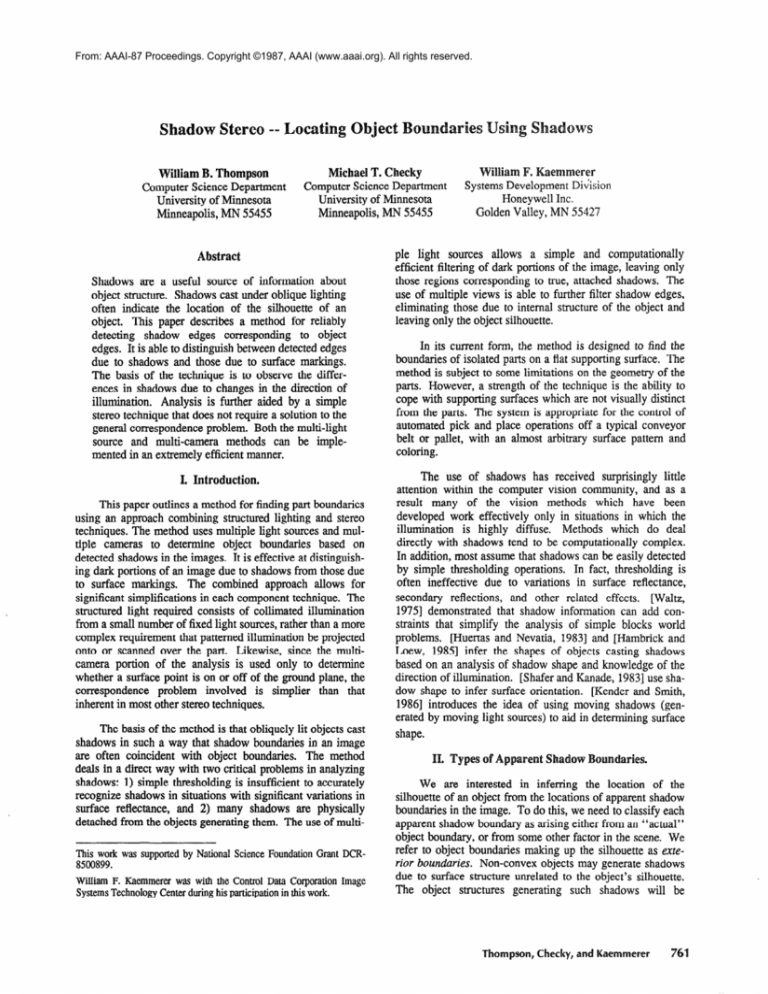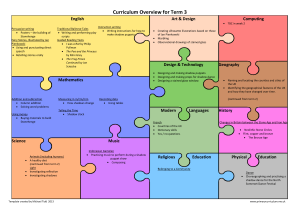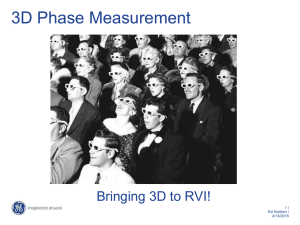
From: AAAI-87 Proceedings. Copyright ©1987, AAAI (www.aaai.org). All rights reserved.
Shadow Stereo -- Loc
William
B. Thompson
Computer Science Department
University of Minnesota
Minneapolis, MN 55455
Michael T. Cheeky
Computer Science Department
University of Minnesota
Minneapolis, MN 55455
Abstract
Shadows are a useful source of information about
object structure. Shadows cast under oblique lighting
often indicate the location of the silhouette of an
object. This paper describes a method for reliably
detecting shadow edges corresponding to object
edges. It is able to distinguish between detected edges
due to shadows and those due to surface markings.
The basis of the technique is to observe the differences in shadows due to changes in the direction of
illumination. Analysis is further aided by a simple
stereo technique that does not require a solution to the
general correspondenceproblem. Both the multi-light
source and multi-camera methods can be implemented in an extremely efficient manner.
I. Introduction.
This paper outlines a method for finding part boundaries
using an approach combining structured lighting and stereo
techniques. The method uses multiple light sources and multiple cameras to determine object boundaries based on
detected shadows in the images. It is effective at distinguishing dark portions of an image due to shadows from those due
to surface markings. The combined approach allows for
significant simplifications in each component technique. The
structured light required consists of collimated illumination
from a small number of fixed light sources,rather than a more
complex requirement that patterned illumination be projected
onto or scanned over the part. Likewise, since the multicamera portion of the analysis is used only to determine
whether a surface point is on or off of the ground plane, the
correspondence problem involved is simplier than that
inherent in most other stereo techniques.
The basis of the method is that obliquely lit objects cast
shadows in such a way that shadow boundaries in an image
are often coincident with object boundaries. The method
deals in a direct way with two critical problems in analyzing
shadows: 1) simple thresholding is insufficient to accurately
recognize shadows in situations with significant variations in
surface reflectance, and 2) many shadows are physically
detached from the objects generating them. The use of multiThis work was supported by National Science Foundation Grant DCR8500899.
William F. Kaemmerer was with the Control Data Corporation Image
Systems Technology Center during his participation in this work.
Systems Development D&ision
Honeywell Inc.
Golden Valley, MN 55427
pie light sources allows a simple and computationally
efficient filtering of dark portions of the image, leaving only
those regions corresponding to true, attached shadows. The
use of multiple views is able to further filter shadow edges,
eliminating those due to internal structure of the object and
leaving only the object silhouette.
In its current form, the method is designed to find the
boundaries of isolated parts on a flat supporting surface. The
method is subject to some limitations on the geometry of the
parts. However, a strength of the technique is the ability to
cope with supporting surfaces which are not visually distinct
from the parts. The system is appropriate for the control of
automated pick and place operations off a typical conveyor
belt or pallet, with an almost arbitrary surface pattern and
coloring.
The use of shadows has received surprisingly little
attention within the computer vision community, and as a
result many of the vision methods which have been
developed work effectively only in situations in which the
illumination is highly diffuse. Methods which do deal
directly with shadows tend to be computationally complex.
In addition, most assumethat shadowscan be easily detected
by simple thresholding operations. In fact, thresholding is
often ineffective due to variations in surface reflectance,
secondary reflections, and other related effects. [Waltz,
19751 demonstrated that shadow information can add constraints that simplify the analysis of simple blocks world
problems. puertas and Nevatia, 19831 and [Hambrick and
Loew, 19851 infer the shapes of objects casting shadows
based on an analysis of shadow shape and knowledge of the
direction of illumination. [Shafer and Kanade, 19831use shadow shape to infer surface orientation. [Kender and Smith,
19861 introduces the idea of using moving shadows (generated by moving light sources) to aid in determining surface
shape.
We are interested in inferring the location of the
silhouette of an object from the locations of apparent shadow
boundaries in the image. To do this, we need to classify each
apparent shadow boundary as arising either from an “actual”
object boundary, or from some other factor in the scene. We
refer to object boundaries making up the silhouette as exterior boundaries. Non-convex objects may generate shadows
due to surface structure unrelated to the object’s silhouette.
The object structures generating such shadows will be
Thompson, ChEdcy, and Kaemmerer
referred to as interior boundaries.
Shadow regions identified in an image (for example, by
thresholding) can be true shadows, correlated to actual shadows in the scene, or false shadows resulting, for example,
from surface markings. Each point on the boundary of a true
shadow region can be either attached or detached. An
attached shadow boundary point is coincident (in the scene)
with the object generating the shadow. Detached shadow
boundary points correspond either to the “far” side of the
shadow, or to parts of “cast” shadows associated with nonconvex objects. Attached shadow boundary points always
are associated with a point on objects. Detached shadow
boundary points may lie on either the supporting ground
place, or an object in the scene (possibly the same as the
object casting the shadow.)
Any automatic procedure identifying shadows from raw
intensity data will also find false shadow regions. These are
regions of dark intensity in the image which arise from surface markings, that is, spatial patterns in the colors on a surface in the scene,rather than from differences in the illumination falling on the surface. Such markings can occur on
either objects or on the ground plane.
Finally, shadow boundaries can be generated by occlusions. One type of such a boundary arises from the occlusion
of a portion of a shadow region by another illuminated surface nearer to the image plane. The resulting shadow boundary is false in the sensethat it does not reflect the shape of
the true shadow in the scene; nevertheless,it provides useful
information about the location of an external boundary of an
object in the image. Another type arises from a selfocclusion, which occurs when a shadowed surface in the
scene curves out of view in front of an illuminated background.
In summary, a consideration of the ways shadow regions
can appear in an image leads to seven types of apparent shadow boundaries:
1)
2)
3)
4)
5)
6)
7)
attached shadow boundaries
detached shadow boundaries on ground plane
detached shadow boundaries on an object
surface markings on ground plane
surface markings on object
occlusion of shadow by object
self-occlusion of shadowed surface
Of these seven, types 1,6, and 7 provide information on
the location of external boundaries of objects in the scene.A
goal of the following analysis is to develop a technique for
identifying these types of shadow boundaries among all the
shadow boundaries apparent in an image.
III. Assumptions.
A number of simplifying assumptionsare made to facilitate the analysis:
1)
762
Only primary illumination effects are considered, secondary illuminations from reflections are assumed to be
Vision
faint enough to be ignored.
2)
A supporting ground plane at a known location is
assumedto exist.
31
All objects are assumed to be resting directly on the
ground plane.
4)
The surface curvature of the objects at the points
corresponding to their exterior boundaries in the image
is assumed to be high, relative to moderate changes in
the angle of illumination of the scene. In particular,
moderate changes in the angle of illumination should
not significantly affect the location of attached shadow
boundaries in the image.
5)
It is assumed that it is sufficient to find the location of
boundaries defined as the image of silhouettes produced
by a projection along the direction of illumination of the
scene, rather than by a projection from the point of
view. In many applications, the relative positions of
light sources, cameras, and the angle of the object surface at exterior boundaries are such that the difference
between projections are within the tolerance of any
actions based on the visual analysis.
One further assumption will be introduced during the course
of the analysis to lead to the final solution:
6)
Detected shadow regions are assumedto be a manifestation of a single type of underlying cause. For example,
it is presumed that detected regions are not combinations of real shadows and surface markings: (See section VII.)
IV. Leading and Trailing Edges.
A useful first step in classifying the apparent shadow
boundaries in an image is to identify leading versus trailing
shadow edges [Hambrick and Loew, 19851, as follows:
Define a projected illumination direction by projecting the
direction of illumination onto the image plane. Define a shadow leading edge as a transition from light to dark while
moving in the projected illumination direction. A trailing
edge is a transition from dark to light, while moving in the
same direction. Leading edge-trailing edge pairs are
identified by associating with each leading edge point the first
trailing edge point found by moving in the projected illumination direction.
Each leading edge and each trailing edge in the image is
part of an apparent shadow boundary, and hence must be one
of the seven types described in the last section. As a result,
seven types of leading edges, and seven types of trailing
edges may be conceptually identified, for a total of 49 cases.
These casesare shown in Table 1. Ideally, one would like to
have an image analysis technique which allows all of the
unique casesamong the 49 to be distinguished. However, for
the current purpose it is sufficient to have a technique which
will distinguish cases in which leading edges provide information about boundaries from among the other cases:
47 -
l-
Exterior boundary of back lit object.
8-
Exterior boundary (casting “typical” shadow).
13 -
15 -
22 -
Shadow cast onto a surface marking on ground.
27 -
Surface mark on ground partly occluded by
(unmarked) object.
29 -
Shadow cast onto a surface marking on an object.
34 -
Surface mark on object partly occluded by an
overhanging part of an object.
36 -
Shadow cast by an object partly occluded by an
overhanging part of an object.
41 -
Shadow of one object viewed through hole in an
overhanging object, or gap between overhanging
parts of objects.
Camera Technique.
Two sources of information are used to assist in interpreting the shadow boundaries in an image.
Interior boundary (surface protrusion of object casting shadow onto the same object) or shadow cast by
an object onto another nearby object.
Shadow cast by an overhanging part of an object
onto another object, partly occluded by an
overhanging part of a third object (possible with
highly oblique lighting).
43 -
V. Mulltiple Light Source -- Multiple
Shadow cast by an overhanging part of an object,
partly occluded by another overhanging part of an
object.
20 -
Surface mark on self-shadowed object that curves
out of view.
Multiple light sources -A set of images is taken from the same camera position
but using different illumination directions. Jllumination is
varied in such a way that the direction of the projection of the
illumination direction vector onto the ground plane remains
constant. The image of detached shadow boundaries will
move when the illumination direction changes, because the
location of the detached boundary is a trigonometric function
of illumination angle. Attached, occluded, and surface marking boundaries will not move due to small changes in ilhunination. (There is an exception for attached boundaries due to
low curvature surfaces -- but note assumption 5, above.) It is
useful to have several sets of illumination sources, each set
individually satisfying the requirement for a common projected direction. In this way, all exterior boundaries of
objects in the scene cast shadows in at least some of the
images, and it is possible to deal with object boundaries
parallel to the projected direction of illumination.
Multiple cameras--
Self-shadowed surface curving out of view before
light background.
Imaging the scene using multiple cameras allows stereo
techniques to be used to determine whether boundaries are on
Leading Edge:
Trailing
Edge:
attached
II
detached
on ground
detached
on object
sug. mark
on ground
sur$ mark
on object
occlusion
of region
selfocclusion
attached
1
2
3
4
5
6
7
detached
on ground
8
9
10
11
12
13
14
detached
on object
15
16
17
18
19
20
21
surf. mark
on ground
22
23
24
25
26
27
28
surf. mark
on object
29
30
31
32
33
34
35
occlusion
of region
36
37
38
39
40
41
42
seljocclusion
43
44
45
46
47
48
49
Tshb
-W.-a
1:
v -1
Citnntinnn
L-.erll
m-m1Y mubrlvino
..mm- .e”J”‘b
edge - trailing
rnrnhinntinnc
.e-r--Iv..-..I.“I-”
raf
-1 badino
‘w-..“‘a
edge apparent shadow boundary types.
Thompson, Cheeky, and Kaemmerer
763
or off of the ground plane. The analysis is simple, because
stereo triangulation is required only at shadow boundaries
and because only an on versus off ground plane determination is requiredY-not an actual depth meas-urement. On-@
stereo solves this problem without the need for a solution to
correspondenceproblem. The technique is based
the
On the fact that different views of the ground plane will be
distorted in systematic ways due to me camera projection
functions. Knowing the &mera models, it is possible to
determine the view of the ground plane seen from one camera
given the view in the other. In fact it is not necessary to
know the camera models. A target such as a checkerboard
can be placed on the ground plane and then conventional
image warping techniques can be used to determine the
transformation between two different views. (This involves a
‘‘correspondence problem,” but one of a very simple sort.)
The warping will be the same for any patterns on the ground
plane. Given two views of a shadow edge lying on the
ground plane, the location of the edge in one view will be the
same as the transformed location of the same edge in the
second view. If the edge is at a height different from the
ground plane, however, the warping transformation will not
accurately predict the change between different views. To
identify edges not on the ground plane, we need only warp
one image to correspond to the viewing point of the other,
and then look for edges that “move.”
VI. IS-IM/CS-CM
Each apparent shadow boundary thus may be given one
of four labels based on information from the images: LS-CS,
LS-CM, LM-CS, or LM-CM. When these labels are applied
to leading-trailing edge pairs, sixteen possible cases result.
These are the sixteen caseswhich may be distinguished using
information available in the image. The goal of the current
analysis is attained if the 49 different situations (from Table
1) can be mapped onto these 16 cases in a manner such that
the shadows arising from exterior object boundaries are
shown to be distinguishable from all other shadows,using the
information available in an image.
The desired mapping can be constructed by assigning an
LS-LM/CS-CM label to each of the seven types of apparent
shadow *boundaries, based on a consideration of their
behavior under changes in lighting and camera positions.
Attached shadow boundaries do not move with lighting
changes, but they move with changes in camera position,
since actual three-dimensional structure to which they are
attached must’ be above the ground plane (LS-CM).
Detached shadow boundaries do move with changes in
Vision
VII. Leading Edge Interpretation and Filtering.
Given this labeling of the types of apparent shadow
boundaries, the mapping of the 49 situations to the 16 cases
involves a straight-forward “collapsing” of the rows and
columns of Table 1, as shown in Table 2. (Cells in Table 1
which are not physically realizable are omitted.)
Leading Edge:
Trailing
LS-cs
LS-CM
LS-CS
25
22,26,27
LS-CM
32,39
LM-CS
LM-CM
Edge:
LM-CS
LM-CM
23
24
1,29,33,
34,36,40,
41,43 47,
48
30,37
11
8,12,13
9
10
18
15, 19,ZQ
16
17
Designation.
Given the change in the illumination direction from
image-to-image, and the determination of on/off ground
plane from the stereo views, each apparent shadow boundary
in an image of the scenemay be labeled as moving or stationary with respect to the lighting and camera position changes.
Shadows which move with changes in illumination may be
labeled LM, those which do not may be labeled LS. Shadows
which move (relative to their predicted location if they were
at the level of the ground plane) with a change in camera
viewpoint may be labeled CM; those which do not may be
labeled CS.
764
illumination direction. Those on the ground plane appear stationary from different camera viewpoints (LM-CS), and
those falling onto objects appear to move (LM-CM). The
boundaries of surface markings are stationary regardless of
illumination direction, and move with camera viewpoint
depending on whether they are on the ground plane (LS-CS)
or an object (LS-CM).
31,38,45
Table 2: Mapping sf Shadow-Producing Situations Onto
Labeling Possibilities for Leading-Trailing Edge Pairs.
Numbers in cells correspond to the situations in Table 1. Italicized numbers are those situations for which the leading
edge of the pair can provide information on the location of an
exterior boundary.
In Table 2, the situation numbers which are italicized
are those for which the leading edge of the apparent shadow
boundary pair is indicative of the location of an actual exterior object boundary in the scene. Inspection of this table
shows that there is no image information condition (i.e., joint
labeling of leading and trailing edges as LS-LM/CS-CM
types) which uniquely selects the situations providing the
location of exterior boundaries. However, the additional simplifying assumption that shadow regions in the image are due
to a single manifestation rules out the more “esoteric”
shadow-producing situations, (situation numbers 22, 29, and
47.) The assumption that shadows are due to a single manifaatotinn .
;c n#xt PP ~mde4#4.,~
.-a” ;t m:mh+
4L*+ ‘.s.-a..ll”UbUU”ll
la ‘1°C CAD LbauIbuY~
45 IL ‘uL~“L
lUJL
qJyGa.l.
In
fact,
we do not require that the whole shadow satisfy this constraint, but only that each leading/trailing edge pair be due to
a single cause. Table 3 shows the mapping when these situations are eliminated. Under this assumption, there are three
joint labeling conditions which may interpreted as providing
information (from the leading edge) concerning the location







